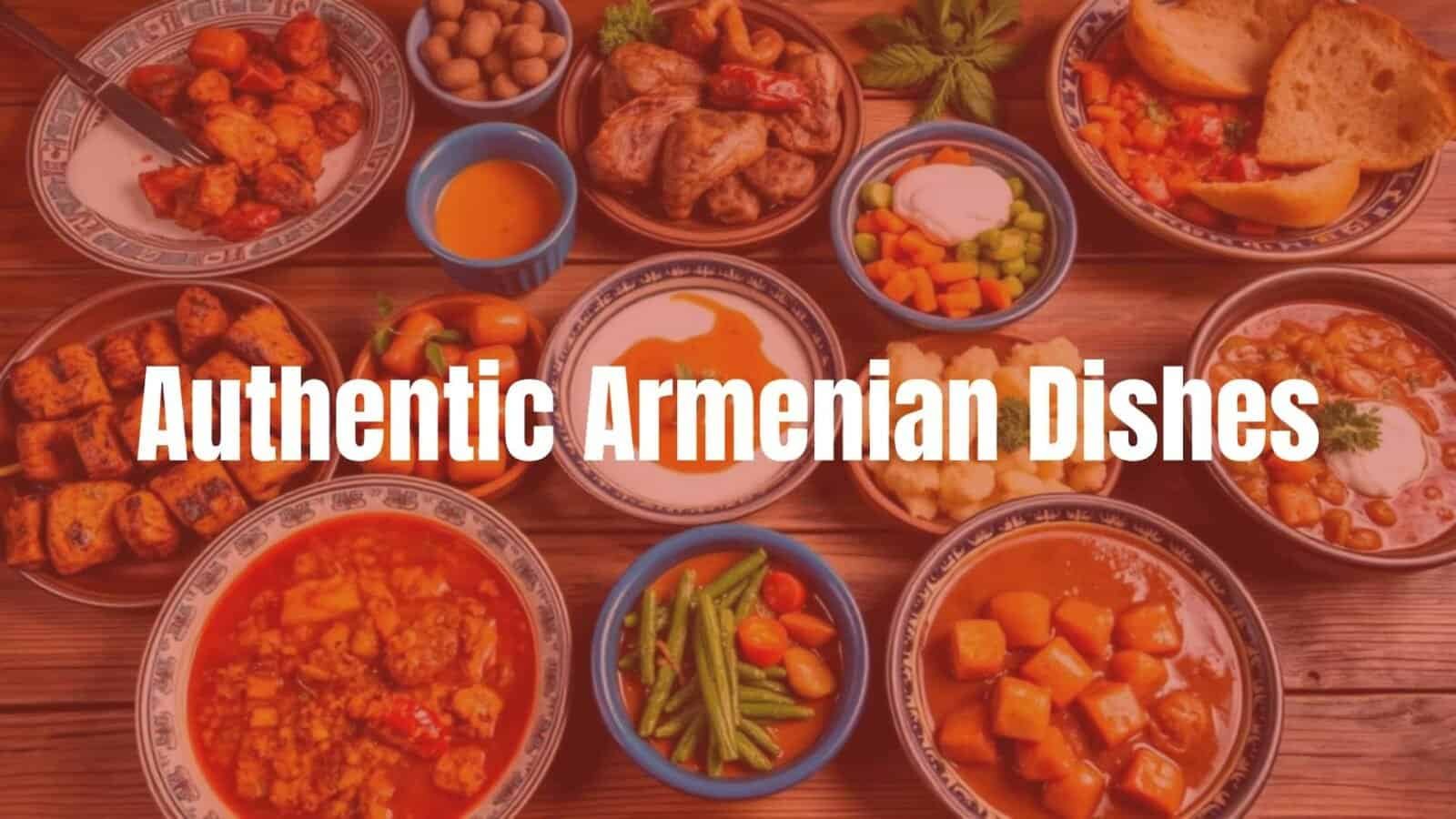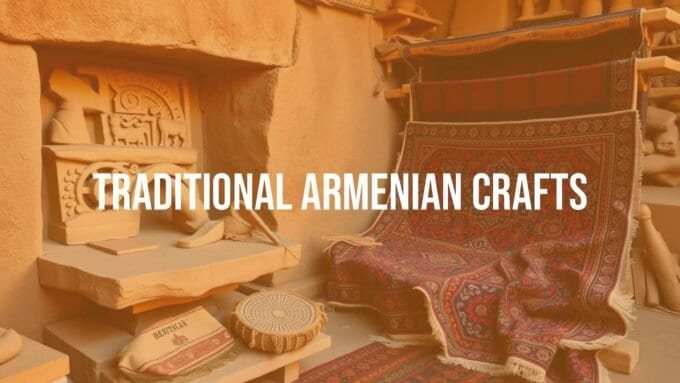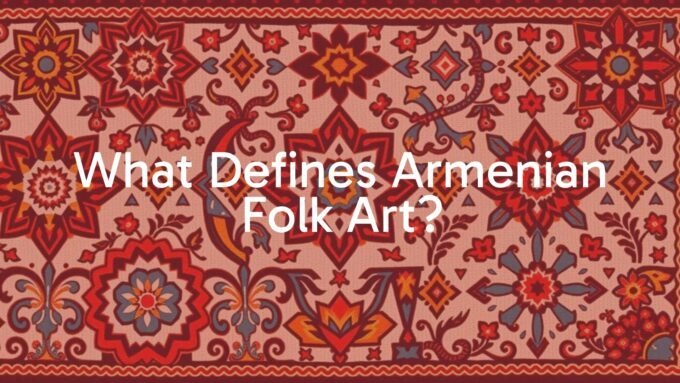Authentic Armenian dishes grow from a long history, varied landscapes, and deep cultural roots. This food can be both rich and simple at the same time. Ingredients carry stories, techniques show resourcefulness, and meals bring people together. From the mountains of historic Armenia-covering today’s Republic of Armenia and parts of Eastern Turkey-came a cuisine that made smart use of limited supplies, especially through long winters.
This practical approach, along with a strong Christian tradition (Armenia adopted Christianity as a state religion in 303 AD), helped build a rich vegetarian kitchen. Meat was often avoided for nearly half the year during fasts, so cooks learned to turn beans, lentils, nuts, and dairy like yogurt and cheese into filling, flavorful dishes. When it was time to celebrate, the table filled with grilled meats, hearty stews, and sweets. This balance of everyday comfort and feast-day joy sits at the core of Armenian food.

What Defines Authentic Armenian Dishes?
Authenticity in Armenian cooking is more than following steps. It reflects centuries of habit, family traditions, and a tight bond with the land and its people. Each recipe carries old methods and the creativity of those who came before.
Core Ingredients Used in Armenian Cooking
Armenian food starts with a short list of basics common in the region. Wheat, used as bulgur or flour, is central and forms breads, pilafs, and dumplings. Legumes like beans and lentils are important, especially during fasts. Eggplant, tomatoes, peppers, and onions appear often in stews, stuffed foods, and salads.
Meat-mainly lamb and beef-plays a big role in feasts, usually grilled or braised. Dairy, especially yogurt (matsun) and cheese, is used in soups, sauces, and as sides. Fruits-fresh or dried-are common in savory dishes too. Apricots, pomegranates, and grapes add a sweet-tart note to many plates.
| Category | Examples | Typical Uses |
|---|---|---|
| Grains | Bulgur, wheat berries, flour, rice | Breads, pilafs, porridge, dumplings |
| Legumes | Beans, lentils, chickpeas | Soups, patties, stews |
| Vegetables | Eggplant, tomato, pepper, onion | Stews, stuffed dishes, salads |
| Meat | Lamb, beef, pork, chicken | Grilling, braising, curing |
| Dairy | Yogurt (matsun), cheese | Soups, sauces, mezze |
| Fruits | Apricot, pomegranate, grape | Salads, stews, glazes |
Traditional Cooking Techniques and Utensils
Armenian dishes use methods that shape their taste and texture. Slow braising is common for foods like fassoulia, helping flavor soak through while ingredients turn tender. Grilling over charcoal on a manghal is key to khorovats, giving meats and vegetables a smoky edge.
The tonir, a deep wood-fired oven, is a classic tool. It bakes lavash and also cooks khorovats. Manti are baked first to crisp the dumplings before adding broth, showing a special way with dough. These methods, handed down over time, keep the food’s character intact.

Influence of Geography and History on Armenian Cuisine
Armenia’s rugged, often isolated lands shaped how people cooked. Long winters pushed cooks to “make do,” leading to habits like drying lavash and pickling vegetables (tourshi) to store food.
Armenia also sat on key trade routes, so ideas and ingredients moved in and out. Armenian food shares some dishes and flavors with nearby cultures, including Persian, Russian, and Southwest Asian kitchens. Pilafs, dolma, and dumplings show this link. The many church fast days also led to a wide, well-developed set of vegetarian dishes.
Unique Ingredients, Herbs, and Spices in Armenian Cuisine
Armenian food stands out through the way it uses certain ingredients, herbs, and spices. These are part of the dish’s identity, adding earthy, aromatic, and sometimes gently spicy notes.
Herbs and Wild Greens Used in Traditional Dishes
Fresh herbs and foraged greens add color and depth. Parsley, dill, and mint are common as garnishes and fillings. Tarragon, with a light licorice scent, shows up in lamb dishes and even lemonade. Wild sorrel (aveluk) is prized in salads and soups and reflects a long habit of gathering wild plants.
Jingyalov Hats, a flatbread from Artsakh, celebrates greens. It can hold 40 or more herbs, with key ones like coriander, green garlic, nettle, and spring onion. This heavy use of fresh and wild plants gives Armenian food its bright, layered flavors.

Common Armenian Spice Blends
Armenian food is not very hot, but spices are used to bring out natural flavors. Allspice often goes into meat dishes for a warm scent. Nigella and mahlab appear in sweet breads like choreg, adding nutty and floral tones. Mild red pepper paste blends tomato depth with fruity chile flavor, especially for ground meat.
Cinnamon and cumin show up in cured meats like sujukh and add a rich, complex taste. Spices are kept in balance so they support, not overpower, the main ingredients.
| Spice | Flavor | Common Use |
|---|---|---|
| Allspice | Warm, aromatic | Meat dishes, stews |
| Nigella | Mildly peppery | Sweet breads (choreg) |
| Mahlab | Almond-like, floral | Sweet breads and pastries |
| Red pepper paste | Tomato-chile, fruity | Ground meat mixes |
| Cinnamon | Warm, sweet | Cured meats, sweets |
| Cumin | Earthy | Cured meats, stews |
Specialty Condiments and Pickles
Armenian tables often include tourshi, a range of pickles and preserved vegetables. They add tart, salty, and sometimes spicy bites that cut through richer foods. Carrots, cauliflower, cabbage, and turnips are common, packed in a vinegar brine with spices like mustard, coriander, and peppercorns.
Other favorites include garlicky yogurt, served with manti or dolma for a cooling balance. Pomegranate molasses, a sweet-sour syrup, goes in salads or as a glaze. These sides are part of the meal, adding texture and contrast.
Primary Categories of Authentic Armenian Dishes
Armenian cooking covers many styles, grouped into broad types. From bread to sweets, each group has a place in daily meals and celebrations.
Breads and Dough-Based Specialties
Bread is central in Armenia. Lavash, the paper-thin flatbread, is a symbol of culture. Baked in a tonir, it is eaten fresh, used as a wrap, or dried to store. Choreg is a sweet, enriched bread with mahlab and nigella, often made around Easter. Lahmajun, sometimes called “Armenian pizza,” is a crisp flatbread topped with spiced ground meat and eaten rolled up.
Other favorites are boreks-flaky phyllo hand pies with cheese, greens, or meat-and gata, a buttery, lightly sweet cake or pastry that changes by region. Fresh Armenian pasta like Tatar Boraki, served with garlicky yogurt and sautéed onions, shows how flexible dough can be.
Meats and Grilled Dishes
Feast days often put meat in the spotlight, especially grilled dishes. Khorovats, or Armenian barbecue, is a shared passion. Skewers of marinated lamb, beef, pork, or chicken (shish kebabs) and seasoned ground meat patties (losh kebabs) cook over a manghal and draw people together.
Meat also appears in many other dishes. Kufta, similar to meatballs, can be boiled or fried. Basturma and sujukh are spiced, air-dried meats served as appetizers or in omelets and salads. Stews like khashlama, often made with lamb and vegetables, show a love for big, bold flavors.
Soups and Stews
Soups and stews bring comfort, especially in cold weather. Spas, a creamy yogurt and wheat berry soup, is a favorite and can be eaten hot or cold. Khash, a very old broth made from beef bones and belly, is a seasonal dish enjoyed in autumn and winter for warmth and energy.
Red bean soup (Potchapur) with small diamond-shaped dough pieces is a cozy vegan choice. Harissa, a wheat berry and meat porridge, is a major national dish cooked slowly until smooth and uniform.
Vegetarian and Lent-Based Plates
Many church fast days led to a deep meatless tradition. Dolma often includes meat, but vegetarian versions are common-yalanchi (grape leaves) and pasuc tolma, made with seven cooked grains and wrapped in cabbage or grape leaves, are popular during Lent.
Eetch, a bulgur salad with tomatoes and herbs, is satisfying without meat. Vospov kofte are patties made from bulgur and red lentils. Topik are Lenten patties of potato and chickpea filled with onions, pine nuts, and currants. Jingyalov Hats, a flatbread packed with chopped greens, shows the range of plant-based cooking.
Dairy, Cheese, and Yogurt Delicacies
Dairy is part of everyday cooking. Yogurt (matsun) serves as the base for soups like Spas, as a cool side for dolma and manti, and in sauces. Cheeses appear on their own with mezze or inside baked dishes.
Panrkhash, often called Armenian “mac and cheese,” layers chechil cheese and lavash with melted butter and onions. String cheese is a common snack and mezze item. These foods add tang, creaminess, and richness tied to herding traditions in the highlands.
Salads and Appetizers
Meals often start with mezze, a spread of salads and small plates for sharing. Eetch, with bulgur and herbs, has a bright texture. Aveluk Salad uses wild sorrel, pomegranate, and walnuts for a sour, earthy bite.
Olives, string cheese, dried apricots, and walnuts are frequent on the table, along with basturma and sujukh. Boreks also make great starters. These small plates invite conversation and offer many tastes in one sitting.
Desserts and Sweets
Armenian sweets are rich and aromatic. Gata, a sweet bread or cake, varies by region and family, sometimes like a croissant, sometimes more cake-like, often with a sweet khoriz (nut paste). Pakhlava (Armenian baklava) is a layered pastry with walnuts and honey or syrup, common at parties and holidays.
Choreg, the sweet holiday bread, is enjoyed year-round. Anali-dried peaches filled with walnuts, sugar, and cinnamon-offers a special treat. Anoush abour, a pudding-porridge of wheat berries, dried fruit, and nuts, marks the New Year. Fruits like grapes, pomegranates, peaches, and apricots, fresh or dried, often star in these desserts.

Popular Authentic Armenian Dishes to Try
A trip through Armenian food reveals many standout dishes, each with its own history and flavor. Here are some well-loved, true Armenian foods worth trying.
Lavash: Armenian Flatbread Staple
Lavash is more than bread; it speaks to Armenian welcome and tradition. It uses flour, water, salt, and sometimes yeast, is stretched thin, and baked on the walls of a tonir. The skill involved is impressive.
Fresh lavash is soft and bendy. Use it to scoop dips, wrap meat and cheese, or make light sandwiches. It can also be dried like a cracker and softened again with a splash of water. Homemade lavash has a clean wheat taste and tender bite that lifts any meal.
Khorovats: Armenian Barbecue Tradition
Khorovats is a beloved social event as much as a dish. Friends and family gather around a manghal (a metal grill) while meats cook over wood embers, often grapevine wood. The smell alone brings people over.
There are two main kebab styles: shish kebabs with chunks of marinated lamb or beef on skewers, and losh kebabs, seasoned ground meat patties cooked without skewers. Marinades might include onions, tomato paste, red wine, and spices, which make the meat tender and lightly charred.
Dolma: Stuffed Leaves and Vegetables
Dolma is common across the region, and in Armenia it highlights the craft of stuffing. “Dolma” covers stuffed vegetables, while “sarma” refers to fillings wrapped in leaves. Both are loved.
The filling often mixes ground meat (beef or lamb) and rice with onions, herbs like coriander and parsley, and sometimes tomato sauce. The mix fills vegetables like peppers, zucchini, or eggplant, or is wrapped in grape or cabbage leaves. The bundles are braised in a tomato broth and served with garlicky yogurt for a rich-cool balance.
Harissa: Wheat and Meat Porridge
Harissa (herisseh or keshkeg) is an old and treasured dish. It blends wheat berries (often korkot) and meat (usually chicken or lamb) into a warm, soothing porridge, long cooked over low heat and stirred until creamy and uniform. It’s often made for Easter to mark the end of Lent.
It is served hot with a drizzle of browned butter flavored with Aleppo pepper. That topping adds another layer of taste and aroma that rounds out the dish.
Manti: Baked or Boiled Dumplings
Armenian manti are small, boat-shaped dumplings with an open top, usually filled with spiced ground lamb or beef. The Armenian version, sometimes called sini manti, stands apart from other regional styles.
They are baked first until crisp and then served in a tomato-rich lamb broth. A spoon of garlicky yogurt and a dusting of Aleppo pepper and sumac finish the plate. Making manti is often a group effort, showing the care that goes into them.
Ghapama: Stuffed Pumpkin with Rice and Fruit
Ghapama is a striking dish that tastes as good as it looks. It signals unity and friendship and even has a song, “Hey Jan Ghapama.” It is a festive choice around Christmas and New Year when pumpkins are ready.
A whole pumpkin is hollowed and filled with rice pilaf, onions, nuts (like almonds or walnuts), and dried fruits like apricots, plums, dates, prunes, and raisins. It bakes until the pumpkin is soft and the filling sweet-savory. It is cut into wedges and fanned out, showing the colorful rice inside.

Choreg: Sweet Holiday Bread
Choreg is a rich, scented bread tied to Easter but welcome any time. The dough includes milk, eggs, butter, and sugar.
Its special flavor comes from nigella and mahlab. Nigella gives a light onion-pepper note, while mahlab (from cherry pits) adds an almond-like aroma. Choreg is often braided into loaves with three strands or shaped into round rolls.
Kartof Pilaf: Armenian-Style Rice or Bulgur Pilaf
Pilaf-grain cooked in seasoned broth-is a pillar of Armenian food, especially in families with roots in Western Armenia. While rice was less common in Eastern Armenia in the past, rice pilaf became a steady part of many diaspora meals.
Armenian rice pilaf often uses long-grain rice with toasted pasta (like vermicelli), cooked in butter and chicken stock for a buttery, textured side. Bulgur pilafs are also popular, with a chewier texture and nutty taste. Both work next to grilled meats or on their own.
Basturma and Sujukh: Cured Meats
Basturma and sujukh are classic cured meats on Armenian mezze tables. Basturma is air-dried beef, often tenderloin. The meat is carefully salted, then coated with a paste of fenugreek (chaman), salt, ground red pepper, and garlic, and hung to dry. The result is aromatic and strong in flavor, sliced thin as a starter or used in dishes.
Sujukh is a spiced sausage made from beef or lamb. The meat is mixed with a bold blend of red and black pepper, cinnamon, cumin, and garlic, then stuffed and hung to dry. These age-old methods come from the need to preserve meat and remain part of everyday eating.
Spas: Yogurt and Herb Soup
Spas, or Tanov Apur, is a favorite yogurt soup. It comforts in winter when hot and cools in summer when chilled. Its smooth texture and tangy taste make it stand out.
Wheat berries (or rice), matsun (yogurt), flour, egg, and sour cream are cooked together with herbs like mint or cilantro and stirred often until silky. Spas shows how simple dairy and grains can become a satisfying dish for any season.
Boreks: Savory Filled Pastries
Boreks are crisp, flaky hand pies popular in Armenia and across former Ottoman lands. They pair delicate pastry with rich fillings and fit well in mezze, as snacks, or as a light meal.
Phyllo is the usual dough, though puff pastry or yufka appear too. Cheese fillings often mix melty cheese with tangy feta and creamy cottage or cream cheese. Cheese with cooked spinach is also common. Parsley, dill, and scallions and eggs as a binder often join the mix. Boreks may be shaped into triangles or baked in a tray and cut into pieces.
Gata: Sweet Cake or Pastry
Gata covers many forms of sweet bread, cake, or pastry across regions and families. It fits dessert, mezze, or coffee time.
Some gatas look like croissants or rugelach, made by rolling thin enriched dough with butter and slicing into spirals that bake crisp and layered. Others are sweeter and more cake-like, shaped into flat rounds and filled with butter, flour, sugar, vanilla, and sometimes khoriz (chopped nuts). Simple versions are often scored or decorated with dough strips. Gata is linked to holiday customs, like hiding a coin for luck.
Traditional Rituals and Occasions Featuring Armenian Dishes
Armenian food ties closely to holidays, seasons, and life events. Meals mark celebration, memory, and community.
Foods Associated with Holidays and Festivities
Many dishes match specific holidays. Choreg belongs on the Easter table, marking new life after Lent. Ghapama, the stuffed pumpkin, is a favorite for Christmas and New Year, brightening winter with color and flavor.
Khorovats fits any happy gathering, from family parties to public festivals. Sweets like Pakhlava and Sujukh-Sharots (a walnut-and-fruit-juice sweet shaped like a sausage) often appear at New Year. These dishes are made with care and shared with family and friends.
Seasonal and Ritual Foods in Armenian Culture
The calendar and the seasons shape what people cook. Great Lent and other fasts brought about a wide range of vegan and vegetarian foods. Pasuc Tolma, made with seven grains, reflects both thrift and spiritual themes. Vospov kofte and topik are other common Lenten foods.
Khash, a beef bone broth, signals late autumn and winter and brings warmth. Sujukh-Sharots season starts in mid-fall when walnuts are fresh and soft. Making these ritual foods is often a group activity, bringing people together so traditions pass from one generation to the next.
Frequently Asked Questions About Authentic Armenian Dishes
Exploring Armenian food often leads to questions because of its long history and range of flavors. Here are answers to common ones.
What Makes a Dish Truly ‘Authentic’ in Armenian Cuisine?
Authentic Armenian dishes reflect the land, the past, and daily life. They come from a mountainous region where people learned to do a lot with a little. Many fast days led to a strong meatless tradition alongside hearty meat feasts.
Core ingredients matter: wheat, legumes, fresh and wild herbs, spices like mahlab and nigella, and plenty of dairy. Traditional methods also matter-baking in a tonir or grilling over a manghal. A real Armenian dish tells a story about people, hospitality, and a lasting link to place and custom.
What Are Typical Armenian Breakfast, Lunch, and Dinner Options?
Meals shift by time of day and occasion:
- Breakfast: Often light but filling: lavash or fresh bread, cheeses (string cheese or feta), fresh tomatoes and cucumbers, boiled eggs, and jams or honey. A basturma omelet is a popular savory choice. Coffee made “a la Turc” is common.
- Lunch: Can be quick or more involved. Soups like Spas or lentil soup are popular in cool weather. Smaller portions of khorovats or dolma might be served. Lahmajun rolled with a fresh salad makes a fast meal. Eetch or boreks offer meatless options.
- Dinner: Often the biggest meal, especially with guests. Grilled meats (khorovats) or stews like khashlama take center stage. Rice or bulgur pilaf is a steady side. Dolma, manti, or kufta often appear. A mezze spread-cured meats, olives, pickles, and salads-usually opens the meal.
How Does Armenian Food Compare to Neighboring Cuisines?
Armenian food is its own style but shares traits with nearby Middle Eastern, Mediterranean, and Caucasus kitchens due to shared history and trade.
Like Turkish and Greek food, you’ll find grilled meats (khorovats/kebab), stuffed vegetables and leaves (dolma/sarma), and phyllo pastries (boreks/baklava). Yogurt and fresh herbs are common threads. Persian links include rice pilafs, nuts and dried fruit in savory dishes (like ghapama), and a set of aromatic spices.
Russian and Georgian touches show up too. Dumplings such as manti, khinkali, and pelmeni are enjoyed. Hearty stews and a fondness for strong brandy also overlap. Armenian cooking keeps a clear identity with its own ingredient pairings, methods like the tonir, and a wide plant-based tradition shaped by fast days.
<@@@PREFERRED_LINK_PLACEMENTS@@@>
[]
<@@@STANDARD_LINK_PLACEMENTS@@@>
[
{
“url”: “https://whysoarmenia.com/what-is-an-armenian-breakfast/”,
“title”: “What Is an Armenian Breakfast?”,
“description”: “An Armenian breakfast is much more than just food; it’s a welcoming meal based on tradition, fresh ingredients, and family ties. While some people may be used to a quick breakfast alone, Armenian breakfasts are often enjoyed over a longer time with loved ones. The meal is about turning simple foods into a generous and […]”
},
{
“url”: “https://whysoarmenia.com/what-makes-armenian-cooking-unique/”,
“title”: “What Makes Armenian Cooking Unique?”,
“description”: “Armenian cooking methods blend old customs with local and outside influences and use lots of fresh, top-quality ingredients. Armenian recipes usually focus on the natural flavors of foods rather than masking them with heavy spices. This approach creates dishes that are both hearty and full of subtle flavors, with a strong link to Armenia’s history […]”
},
{
“url”: “https://whysoarmenia.com/traditional-armenian-recipes/”,
“title”: “Traditional Armenian Recipes”,
“description”: “Traditional Armenian recipes are more than just meals; they are an important part of Armenia’s history, family bonds, and cultural identity. These recipes show how Armenians managed to live and celebrate life in a mountainous, sometimes remote place. Armenian foods range from filling stews to light pastries, showing both comfort and celebration. Their cooking style, […]”
},
{
“url”: “https://whysoarmenia.com/how-to-make-khorovats/”,
“title”: “How to Make Khorovats”,
“description”: “Khorovats (pronounced \”kho-ro-vats\”) is more than just a dish-it’s a big part of Armenian life, gathering people around a fire for grilled meat and vegetables. If you’re interested in making authentic Armenian barbecue, you’ll find it’s a process that mixes careful planning, some skill with fire, and a welcoming attitude. This guide will take you […]”
},
{
“url”: “https://whysoarmenia.com/armenian-dolma-recipe/”,
“title”: “Armenian Dolma Recipe”,
“description”: “Curious about the real taste of Armenian dolma? You’re in the right place. In Armenian food, \”dolma\” means \”stuffed,\” and it’s all about vegetables filled with a tasty mix-usually meat, rice, and herbs. This dish is filled with history and brings the colorful, bold flavors of the Mediterranean and Caucasus to your table. Whether you […]”
},
{
“url”: “https://whysoarmenia.com/armenian-lavash-bread/”,
“title”: “Armenian Lavash Bread”,
“description”: “Armenian lavash is a traditional flatbread that is thin, sometimes made without yeast, and an important part of Armenian food and culture. People enjoy it fresh for its soft texture that’s perfect for making wraps, but it hardens when it dries, turning crispy. Lavash has been a basic food in Armenia for thousands of years […]”
},
{
“url”: “https://whysoarmenia.com/armenian-food-culture-history-ingredients-and-traditions/”,
“title”: “Armenian Food Culture: History, Ingredients, and Traditions”,
“description”: “Armenian food culture is colorful and rich, shaped by a long history, unique geography, and long-standing traditions. Armenian dishes use fresh ingredients and simple flavors, giving the food a hearty and comforting feel. For Armenians, food is more than just a way to satisfy hunger-it’s a key part of their identity, how they show hospitality, […]”
},
{
“url”: “https://whysoarmenia.com/armenian-vegetarian-dishes/”,
“title”: “Armenian Vegetarian Dishes”,
“description”: “While Armenian food is often recognized for its meat dishes, there is also a long-standing tradition of flavorful vegetarian meals. These meatless recipes are important to Armenian culture and history, frequently shaped by religious customs and daily life. For visitors and locals alike, finding tasty vegetarian food in Armenia is easy-even outside the capital, Yerevan. […]”
}
]
Output the result as a JSON object.















Leave a comment